Abstract
Immunoreactivity similar to that of corticotropin-releasing factor (CRF) is found in regions of the central nervous system that modulate autonomic responses, including gastrointestinal functions. We examined the central nervous system effects of ovine CRF on gastric acid secretion in conscious dogs. Male beagle dogs (11-13 kg) were fitted with chronic intracerebroventricular cannulae and gastric fistulae. Gastric acid secretion in response to intravenously administered gastric secretory stimuli was measured by in vitro titration of gastric juice to pH 7.0 and in response to an intragastric meal by in vivo intragastric titration at pH 5.0. Plasma gastrin was determined by radioimmunoassay. CRF microinjected into the third cerebral ventricle decreased pentagastrin-stimulated gastric acid secretion for 3 h (P less than 0.01) dose-dependently (0.2-6.0 nmol X kg-1). CRF did not inhibit histamine-stimulated gastric secretion but significantly (P less than 0.01) decreased the secretory response after 2-deoxy-D-glucose for 3 h. The gastric inhibitory action of intracerebroventricularly administered CRF on pentagastrin-stimulated gastric acid secretion was completely abolished by ganglionic blockade with chlorisondamine. The opioid antagonist, naloxone, and the vasopressin antagonist, [1-deaminopenicillamine,2-(O-methyl) tyrosine,8-arginine]-vasopressin, significantly suppressed the inhibitory effect of CRF on gastric acid secretion stimulated by pentagastrin. In contrast, truncal vagotomy did not prevent the inhibition of gastric acid secretion induced by CRF. CRF (0.2-2.0 nmol X kg-1) administered intracerebroventricularly decreased gastric acid secretion stimulated by 200-ml liquid meals containing 8% peptone. CRF did not affect plasma gastrin concentrations. These results indicate that CRF microinjected into the third cerebral ventricle inhibits gastric acid secretion in conscious dogs. CRF-induced inhibition of gastric acid secretion appears to be mediated by the sympathetic nervous system and, in part, by opiate and vasopressin-dependent mechanisms.
Full text
PDF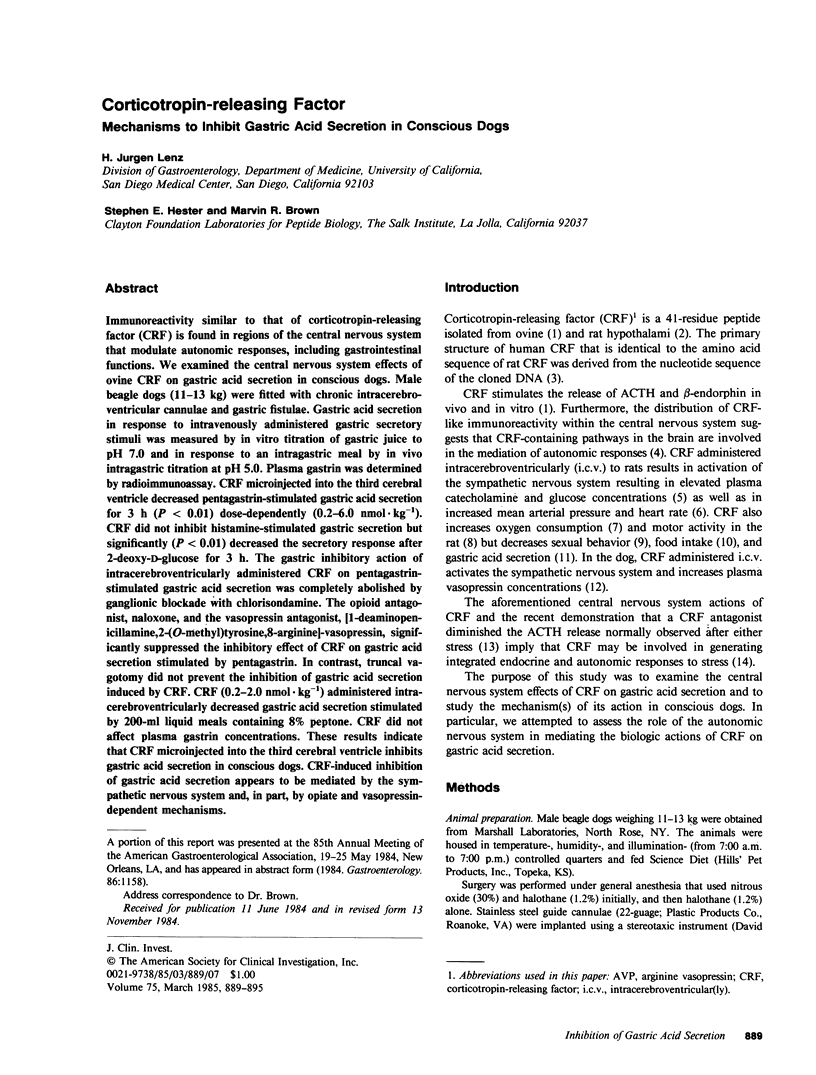
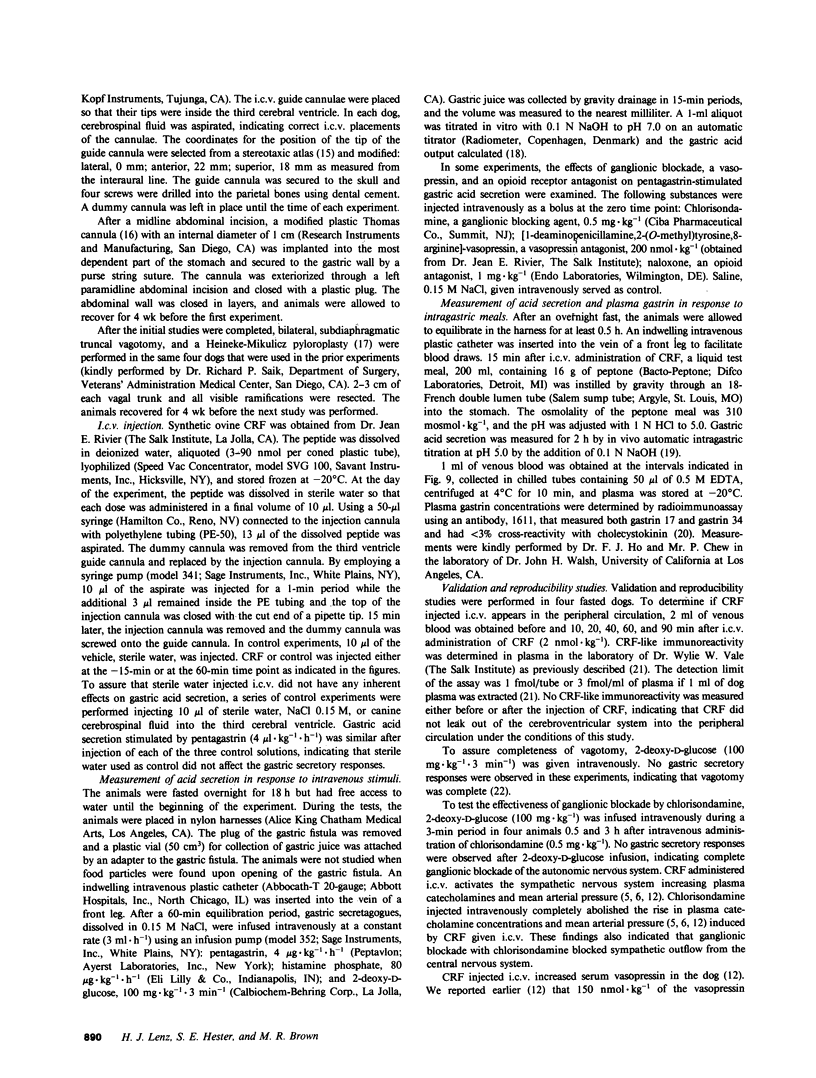
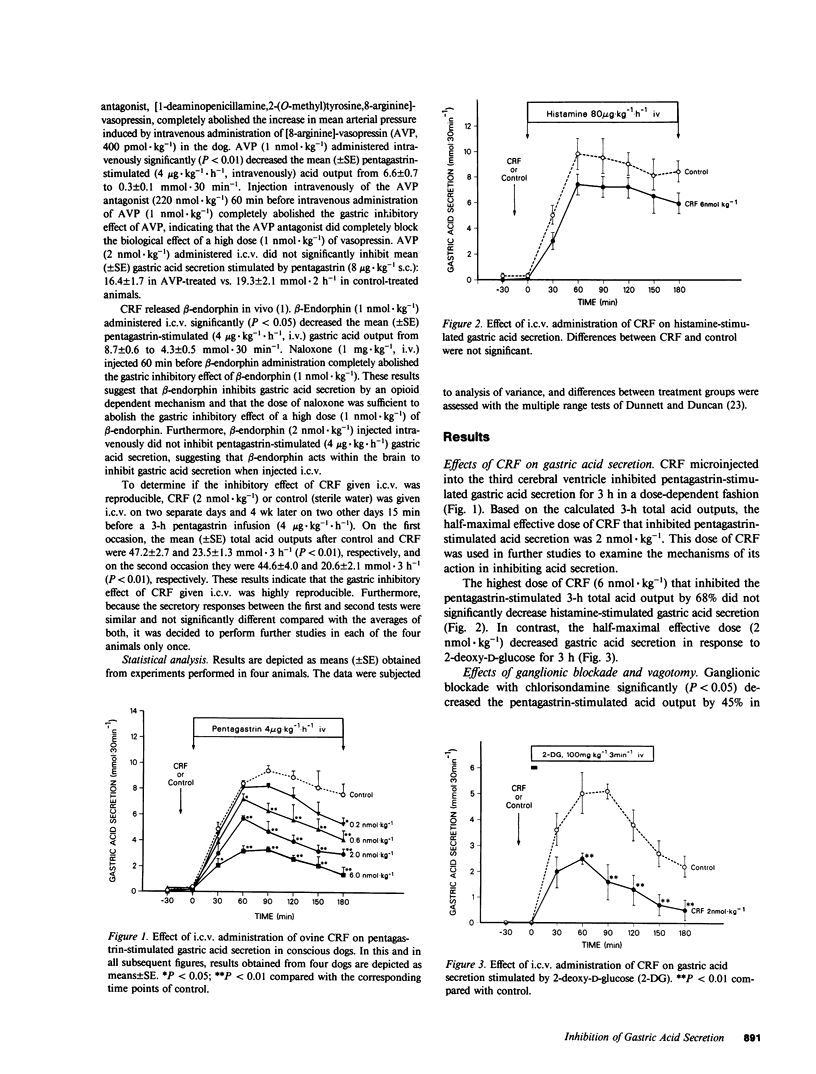
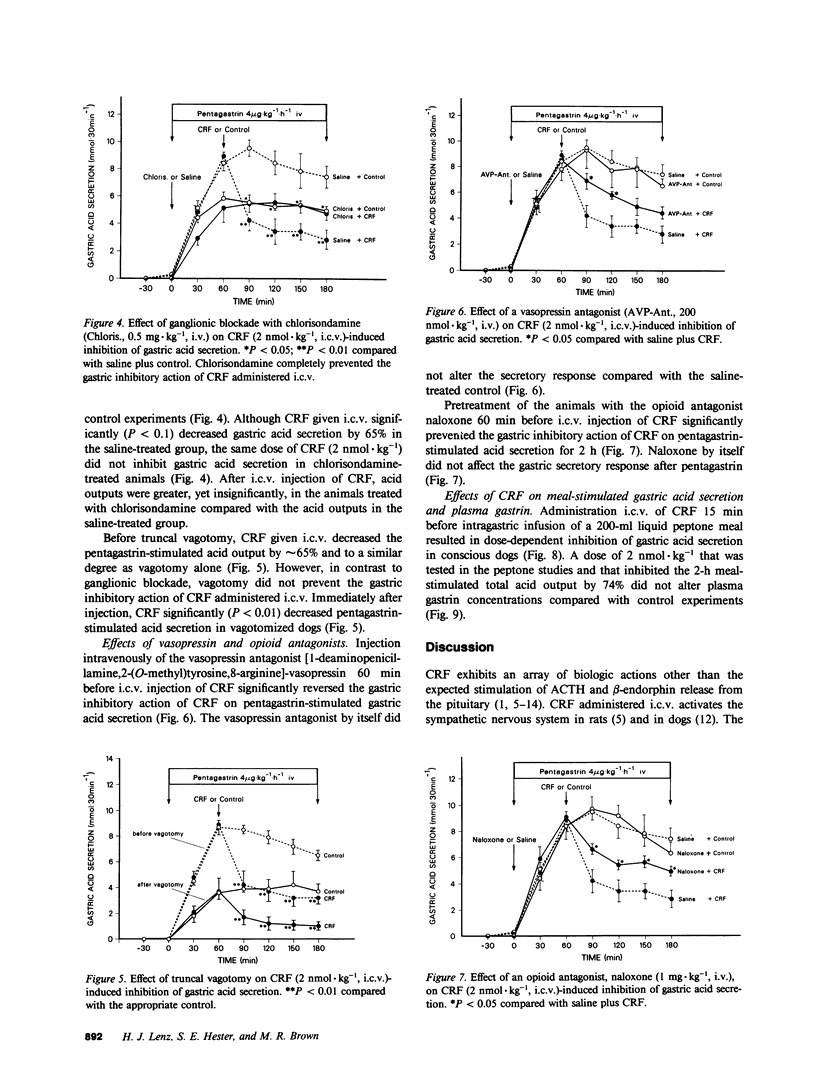
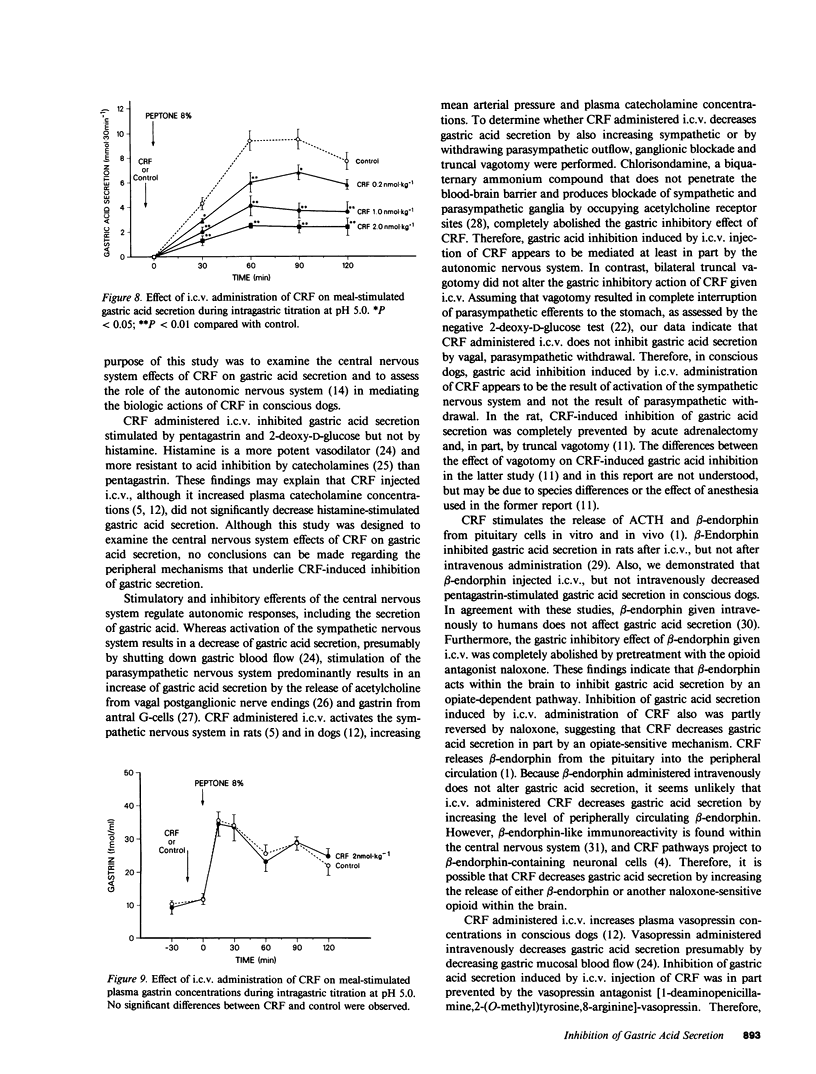
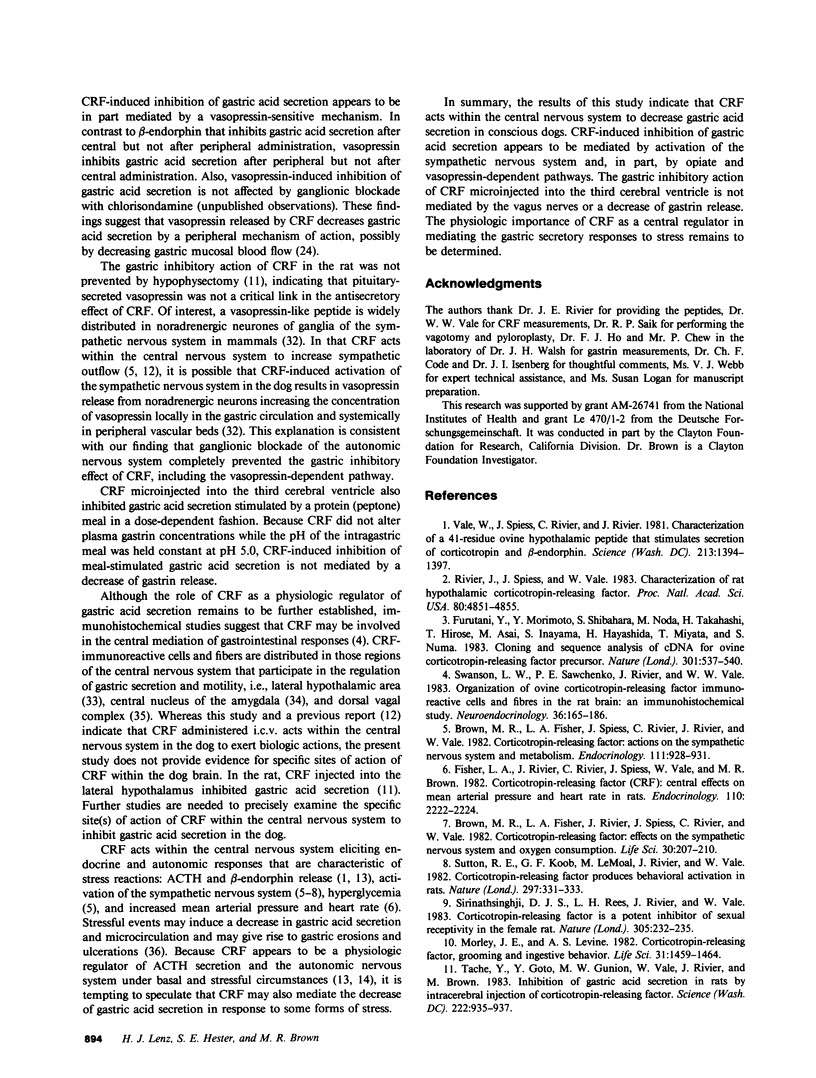
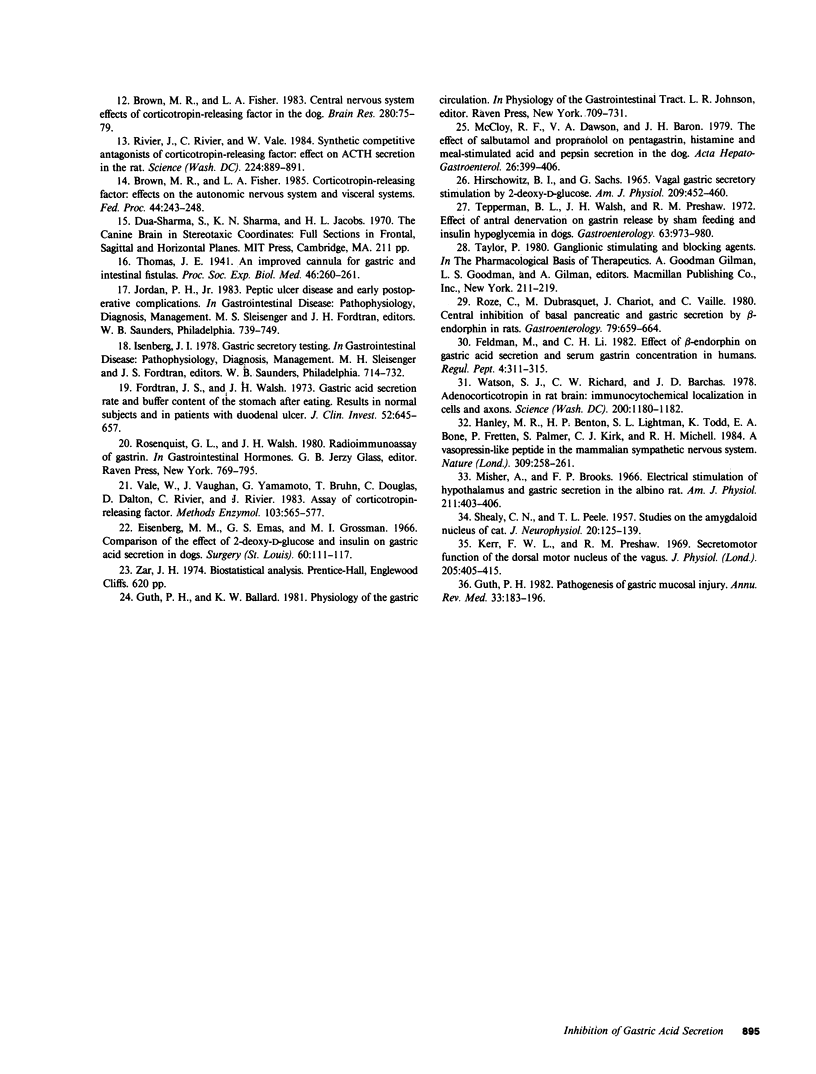
Selected References
These references are in PubMed. This may not be the complete list of references from this article.
- Brown M. R., Fisher L. A. Central nervous system effects of corticotropin releasing factor in the dog. Brain Res. 1983 Nov 28;280(1):75–79. doi: 10.1016/0006-8993(83)91175-7. [DOI] [PubMed] [Google Scholar]
- Brown M. R., Fisher L. A. Corticotropin-releasing factor: effects on the autonomic nervous system and visceral systems. Fed Proc. 1985 Jan;44(1 Pt 2):243–248. [PubMed] [Google Scholar]
- Brown M. R., Fisher L. A., Rivier J., Spiess J., Rivier C., Vale W. Corticotropin-releasing factor: effects on the sympathetic nervous system and oxygen consumption. Life Sci. 1982 Jan 11;30(2):207–210. doi: 10.1016/0024-3205(82)90654-3. [DOI] [PubMed] [Google Scholar]
- Brown M. R., Fisher L. A., Spiess J., Rivier C., Rivier J., Vale W. Corticotropin-releasing factor: actions on the sympathetic nervous system and metabolism. Endocrinology. 1982 Sep;111(3):928–931. doi: 10.1210/endo-111-3-928. [DOI] [PubMed] [Google Scholar]
- Feldman M., Li C. H. Effect of beta-endorphin on gastric acid secretion and serum gastrin concentration in humans. Regul Pept. 1982 Nov;4(6):311–315. doi: 10.1016/0167-0115(82)90141-0. [DOI] [PubMed] [Google Scholar]
- Fisher L. A., Rivier J., Rivier C., Spiess J., Vale W., Brown M. R. Corticotropin-releasing factor (CRF): central effects on mean arterial pressure and heart rate in rats. Endocrinology. 1982 Jun;110(6):2222–2224. doi: 10.1210/endo-110-6-2222. [DOI] [PubMed] [Google Scholar]
- Fordtran J. S., Walsh J. H. Gastric acid secretion rate and buffer content of the stomach after eating. Results in normal subjects and in patients with duodenal ulcer. J Clin Invest. 1973 Mar;52(3):645–657. doi: 10.1172/JCI107226. [DOI] [PMC free article] [PubMed] [Google Scholar]
- Furutani Y., Morimoto Y., Shibahara S., Noda M., Takahashi H., Hirose T., Asai M., Inayama S., Hayashida H., Miyata T. Cloning and sequence analysis of cDNA for ovine corticotropin-releasing factor precursor. Nature. 1983 Feb 10;301(5900):537–540. doi: 10.1038/301537a0. [DOI] [PubMed] [Google Scholar]
- Guth P. H. Pathogenesis of gastric mucosal injury. Annu Rev Med. 1982;33:183–196. doi: 10.1146/annurev.me.33.020182.001151. [DOI] [PubMed] [Google Scholar]
- Hanley M. R., Benton H. P., Lightman S. L., Todd K., Bone E. A., Fretten P., Palmer S., Kirk C. J., Michell R. H. A vasopressin-like peptide in the mammalian sympathetic nervous system. Nature. 1984 May 17;309(5965):258–261. doi: 10.1038/309258a0. [DOI] [PubMed] [Google Scholar]
- Hirschowitz B. I., Sachs G. Vagal gastric secretory stimulation by 2-deoxy-D-glucose. Am J Physiol. 1965 Sep;209(3):452–460. doi: 10.1152/ajplegacy.1965.209.3.452. [DOI] [PubMed] [Google Scholar]
- Kerr F. W., Preshaw R. M. Secretomotor function of the dorsal motor nucleus of the vagus. J Physiol. 1969 Nov;205(2):405–415. doi: 10.1113/jphysiol.1969.sp008974. [DOI] [PMC free article] [PubMed] [Google Scholar]
- McCloy R. F., Dawson V. A., Baron J. H. The effect of salbutamol and propranolol on pentagastrin, histamine and meal-stimulated acid and pepsin secretion in the dog. Acta Hepatogastroenterol (Stuttg) 1979 Oct;26(5):399–406. [PubMed] [Google Scholar]
- Misher A., Brooks F. P. Electrical stimulation of hypothalamus and gastric secretion in the albino rat. Am J Physiol. 1966 Aug;211(2):403–406. doi: 10.1152/ajplegacy.1966.211.2.403. [DOI] [PubMed] [Google Scholar]
- Morley J. E., Levine A. S. Corticotrophin releasing factor, grooming and ingestive behavior. Life Sci. 1982 Oct 4;31(14):1459–1464. doi: 10.1016/0024-3205(82)90007-8. [DOI] [PubMed] [Google Scholar]
- Rivier J., Rivier C., Vale W. Synthetic competitive antagonists of corticotropin-releasing factor: effect on ACTH secretion in the rat. Science. 1984 May 25;224(4651):889–891. doi: 10.1126/science.6326264. [DOI] [PubMed] [Google Scholar]
- Rivier J., Spiess J., Vale W. Characterization of rat hypothalamic corticotropin-releasing factor. Proc Natl Acad Sci U S A. 1983 Aug;80(15):4851–4855. doi: 10.1073/pnas.80.15.4851. [DOI] [PMC free article] [PubMed] [Google Scholar]
- Rozé C., Dubrasquet M., Chariot J., Vaille C. Central inhibition of basal pancreatic and gastric secretions by beta-endorphin in rats. Gastroenterology. 1980 Oct;79(4):659–664. [PubMed] [Google Scholar]
- SHEALY C. N., PEELE T. L. Studies on amygdaloid nucleus of cat. J Neurophysiol. 1957 Mar;20(2):125–139. doi: 10.1152/jn.1957.20.2.125. [DOI] [PubMed] [Google Scholar]
- Sirinathsinghji D. J., Rees L. H., Rivier J., Vale W. Corticotropin-releasing factor is a potent inhibitor of sexual receptivity in the female rat. Nature. 1983 Sep 15;305(5931):232–235. doi: 10.1038/305232a0. [DOI] [PubMed] [Google Scholar]
- Sutton R. E., Koob G. F., Le Moal M., Rivier J., Vale W. Corticotropin releasing factor produces behavioural activation in rats. Nature. 1982 May 27;297(5864):331–333. doi: 10.1038/297331a0. [DOI] [PubMed] [Google Scholar]
- Swanson L. W., Sawchenko P. E., Rivier J., Vale W. W. Organization of ovine corticotropin-releasing factor immunoreactive cells and fibers in the rat brain: an immunohistochemical study. Neuroendocrinology. 1983;36(3):165–186. doi: 10.1159/000123454. [DOI] [PubMed] [Google Scholar]
- Taché Y., Goto Y., Gunion M. W., Vale W., River J., Brown M. Inhibition of gastric acid secretion in rats by intracerebral injection of corticotropin-releasing factor. Science. 1983 Nov 25;222(4626):935–937. doi: 10.1126/science.6415815. [DOI] [PubMed] [Google Scholar]
- Tepperman B. L., Walsh J. H., Preshaw R. M. Effect of antral denervation on gastrin release by sham feeding and insulin hypoglycemia in dogs. Gastroenterology. 1972 Dec;63(6):973–980. [PubMed] [Google Scholar]
- Vale W., Spiess J., Rivier C., Rivier J. Characterization of a 41-residue ovine hypothalamic peptide that stimulates secretion of corticotropin and beta-endorphin. Science. 1981 Sep 18;213(4514):1394–1397. doi: 10.1126/science.6267699. [DOI] [PubMed] [Google Scholar]
- Vale W., Vaughan J., Yamamoto G., Bruhn T., Douglas C., Dalton D., Rivier C., Rivier J. Assay of corticotropin releasing factor. Methods Enzymol. 1983;103:565–577. doi: 10.1016/s0076-6879(83)03040-2. [DOI] [PubMed] [Google Scholar]
- Watson S. J., Richard C. W., 3rd, Barchas J. D. Adrenocorticotropin in rat brain: immunocytochemical localization in cells and axons. Science. 1978 Jun 9;200(4346):1180–1182. doi: 10.1126/science.206967. [DOI] [PubMed] [Google Scholar]


